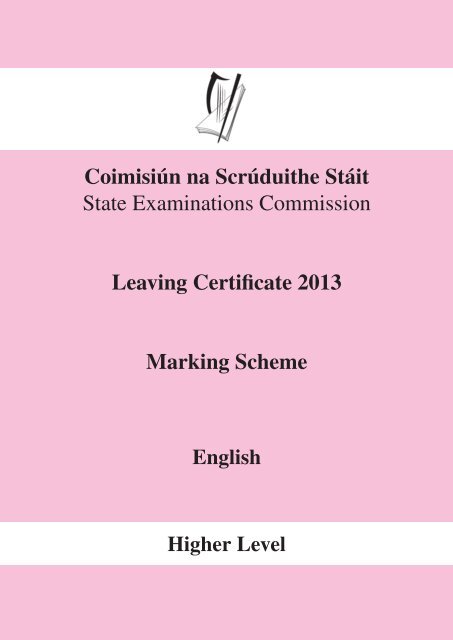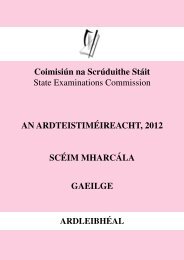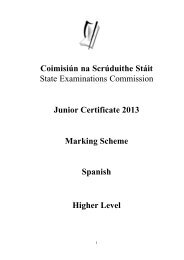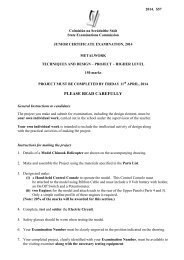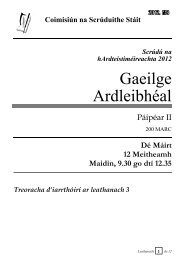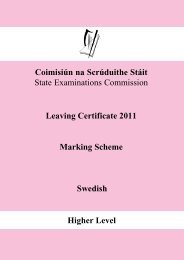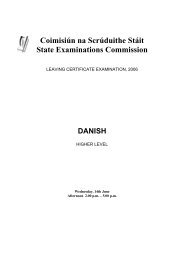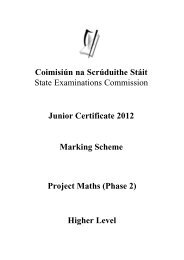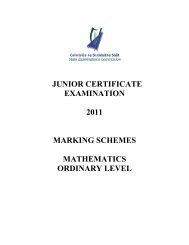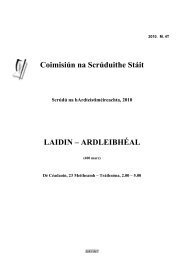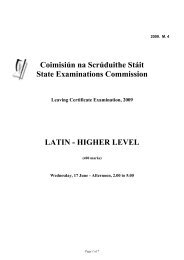Marking Scheme - Examinations.ie
Marking Scheme - Examinations.ie
Marking Scheme - Examinations.ie
Create successful ePaper yourself
Turn your PDF publications into a flip-book with our unique Google optimized e-Paper software.
Coimisiún na Scrúduithe Stáit<br />
State <strong>Examinations</strong> Commission<br />
Leaving Certificate 2012 2013<br />
<strong>Marking</strong> <strong>Scheme</strong><br />
Design and Communication English Graphics<br />
Higher Level
Note to teachers and students on the use of published marking schemes<br />
<strong>Marking</strong> schemes published by the State <strong>Examinations</strong> Commission are not intended to be<br />
standalone documents. They are an essential resource for examiners who receive training in<br />
the correct interpretation and application of the scheme. This training involves, among other<br />
things, marking samples of student work and discussing the marks awarded, so as to clarify<br />
the correct application of the scheme. The work of examiners is subsequently monitored by<br />
Advising Examiners to ensure consistent and accurate application of the marking scheme.<br />
This process is overseen by the Ch<strong>ie</strong>f Examiner, usually assisted by a Ch<strong>ie</strong>f Advising<br />
Examiner. The Ch<strong>ie</strong>f Examiner is the final authority regarding whether or not the marking<br />
scheme has been correctly appl<strong>ie</strong>d to any p<strong>ie</strong>ce of candidate work.<br />
<strong>Marking</strong> schemes are working documents. While a draft marking scheme is prepared in<br />
advance of the examination, the scheme is not finalised until examiners have appl<strong>ie</strong>d it to<br />
candidates’ work and the feedback from all examiners has been collated and considered in<br />
light of the full range of responses of candidates, the overall level of difficulty of the<br />
examination and the need to maintain consistency in standards from year to year. This<br />
published document contains the finalised scheme, as it was appl<strong>ie</strong>d to all candidates’ work.<br />
In the case of marking schemes that include model solutions or answers, it should be noted<br />
that these are not intended to be exhaustive. Variations and alternatives may also be<br />
acceptable. Examiners must consider all answers on their merits, and will have consulted<br />
with their Advising Examiners when in doubt.<br />
Future <strong>Marking</strong> <strong>Scheme</strong>s<br />
Assumptions about future marking schemes on the basis of past schemes should be avoided.<br />
While the underlying assessment principles remain the same, the details of the marking of a<br />
particular type of question may change in the context of the contribution of that question to<br />
the overall examination in a given year. The Ch<strong>ie</strong>f Examiner in any given year has the<br />
responsibility to determine how best to ensure the fair and accurate assessment of candidates’<br />
work and to ensure consistency in the standard of the assessment from year to year.<br />
Accordingly, aspects of the structure, detail and application of the marking scheme for a<br />
particular examination are subject to change from one year to the next without notice.
STATE EXAMINATIONS COMMISSION<br />
LEAVING CERTIFICATE ENGLISH 2013 – HIGHER LEVEL<br />
CRITERIA FOR ASSESSMENT<br />
The tasks set for candidates in both Paper 1 and Paper 2 will be assessed in accordance with the<br />
following criteria:<br />
Clarity of Purpose (P) 30% of the marks available for the task<br />
Coherence of Delivery (C) 30% of the marks available for the task<br />
Effic<strong>ie</strong>ncy of Language Use (L) 30% of the marks available for the task<br />
Accuracy of Mechanics (M) 10% of the marks available for the task<br />
Each answer will be in the form of a response to a specific task, requiring candidates<br />
<br />
<br />
<br />
<br />
To display a clear and purposeful engagement with the set task<br />
To sustain the response in an appropriate manner over the entire answer<br />
To manage and control language appropriate to the task<br />
To display levels of accuracy in spelling and grammar appropriate to the required/chosen<br />
register.<br />
Schematised detail regarding these criteria is to be found in Appendix 1 of this <strong>Marking</strong> <strong>Scheme</strong>.<br />
The Grade Grid utilised for purposes of applying the criteria for assessment throughout the marking<br />
is to be found in Appendix 2 of the <strong>Marking</strong> <strong>Scheme</strong>.<br />
Where discrete criteria awarding is in operation, marks will be indicated on candidates’ scripts in all<br />
instances in the order in which they are set out above. Thus Clarity of Purpose will always appear<br />
first in the list of marks. Marks awarded for Coherence of Delivery will follow and so on to the end.<br />
Use of Codes<br />
To assist with forming a judgement, it will be necessary to place an accurate tick at the points<br />
identif<strong>ie</strong>d in the answer and to use the proper shorthand codes as indicated throughout the marking<br />
scheme.<br />
Use of the full range of marks available<br />
Examiners should make themselves familiar with the range of marks available for each of the tasks<br />
set and utilise the full range of marks as appropriate in the course of the marking.<br />
The list of texts prescribed for assessment in 2013 is set out in the Department of Education &<br />
Sc<strong>ie</strong>nce Circular 0004/2011<br />
Assessment will proceed in accordance with the State <strong>Examinations</strong> Commission booklet,<br />
Instructions to Examiners.
Text 1 QA<br />
PAPER 1<br />
SECTION I – COMPREHENDING (100 marks)<br />
GENERAL<br />
“This paper will be specifically aimed at testing the comprehending and<br />
composing abilit<strong>ie</strong>s of students.” (DES English Syllabus, 7.3)<br />
Candidates must answer a Question A on one text and a Question B on a different text.<br />
N.B. Candidates may NOT answer a Question A and a Question B on the same text.<br />
Please note that, in relation to all texts, the candidates may take the introductions and accompanying<br />
illustrations to be integral parts of the texts.<br />
QUESTION A<br />
TEXT 1<br />
(i) What evidence does the writer offer to suggest that readers or v<strong>ie</strong>wers can find cliffhangers<br />
fascinating or alluring? Support your answer with reference to the written text. (15)<br />
Expect candidates to provide evidence to suggest that readers or v<strong>ie</strong>wers do/do not find cliffhangers<br />
fascinating or alluring.<br />
Mark ex 15 by reference to the criteria for assessment.<br />
A+ B C D E-<br />
15 marks 15 – 13 11 9 6 5 – 0<br />
Possible points:<br />
- Victorian fiction “triggered desperation” and “alarmist essays”<br />
- “thrill-packed endings” (radio), “titillating disaster” (mov<strong>ie</strong>s)<br />
- TV cliff-hangers – Dallas – “spawned endless imitators”<br />
- continued popularity – “new breed of serial narrative”<br />
- “something suspect”, “creepy manipulation by a storyteller” Etc.<br />
2
Text 1 QA<br />
(contd.)<br />
(ii) Discuss how effectively each of the visual images (IMAGE 1 and IMAGE 2) helps to<br />
develop your understanding of the cliff-hanger as a storytelling device. In your answer refer<br />
to both of the visual images that illustrate the text. (15)<br />
Expect candidates to “read” both visual images and to discuss the extent to which each helps to<br />
develop an understanding of the cliff-hanger as a story-telling device. Candidates should deal with<br />
both visual images, (though not necessarily equally), and they may take a combined approach to the<br />
images. Allow that “effectively” may be dealt with explicitly or implicitly.<br />
Mark ex 15 by reference to the criteria for assessment.<br />
A+ B C D E-<br />
15 marks 15 – 13 11 9 6 5 – 0<br />
Possible points:<br />
Image 1<br />
- we are left wondering about the fate of three of the characters in peril<br />
- exaggerated/dramatic narrative elements (props, facial expressions) add to the suspense<br />
- black & white image suggests the long-standing popularity of the cliff-hanger<br />
- “To Be Continued” highlights the sensational/manipulative effect<br />
Image 2<br />
- potential catastrophe/rescue used as a compelling narrative device<br />
- aud<strong>ie</strong>nce engaged by the close-up expression conveying fear and dismay<br />
- camera angle/perspective emphasises the dramatic narrative<br />
- contemporary image illustrates the modern appeal of the cliff-hanger Etc.<br />
3
Text 1 QA<br />
(contd.)<br />
(iii) The New Yorker has been described as a magazine that informs, entertains and<br />
comments. Based on your reading of the written extract above, would you agree with<br />
this description? Support your answer with reference to both the content and style of<br />
the written text. (20)<br />
Candidates are free to agree and/or disagree with this v<strong>ie</strong>w, but should address all three elements –<br />
“informs, entertains and comments” (though not necessarily equally).<br />
Candidates should refer to both the content and style of the written text (though, again, not<br />
necessarily equally).<br />
Mark ex 20 by reference to the criteria for assessment.<br />
A+ B C D E-<br />
20 marks 20 – 17 14 11 8 7 – 0<br />
Possible points:<br />
- informs: factual information – definition and history of the cliff-hanger through a var<strong>ie</strong>ty of media<br />
- entertains: range of interesting references, appealing imagery, humorous style<br />
- comments: opinions expressed through a var<strong>ie</strong>ty of thought-provoking v<strong>ie</strong>ws Etc.<br />
4
Text 1 QB<br />
QUESTION B<br />
You have been asked to give a talk to your class entitled: Television and radio in the lives of<br />
young people today. Write the text of the talk you would deliver in which you consider the role<br />
of television and radio in the lives of young people today. (50)<br />
Expect a var<strong>ie</strong>ty of approaches to the talk (formal, informal, personal, serious, humorous,<br />
discursive, etc.), but candidates should consider the role of television and radio in the lives of young<br />
people today. Candidates are expected to refer to both television and radio, though not necessarily<br />
equally.<br />
Mark ex 50 by reference to the criteria for assessment using the following breakdown of marks.<br />
P 15<br />
C 15<br />
L 15<br />
M 5<br />
50 marks A + B C D E-<br />
100% 50 – 43 35 28 20 19 – 0<br />
30% 15 – 13 11 9 6 5 – 0<br />
10% 5 4 3 2 1 – 0<br />
Reward evidence of the following:<br />
- clear appreciation of the task<br />
- consistency of register, sense of aud<strong>ie</strong>nce<br />
- effective use of illustration<br />
- clarity and coherence of v<strong>ie</strong>ws<br />
- quality of the writing<br />
5
Text 2 QA<br />
TEXT 2<br />
QUESTION A<br />
(i) Outline three aspects of William Trevor’s approach to story writing, revealed in the<br />
above interv<strong>ie</strong>w. Support your answer with reference to the text. (15)<br />
Expect candidates to identify and give a br<strong>ie</strong>f account of three aspects of William Trevor’s<br />
approach to story writing.<br />
Mark ex 15 by reference to the criteria for assessment.<br />
A+ B C D E-<br />
15 marks 15 – 13 11 9 6 5 – 0<br />
Possible points:<br />
- for Trevor, story writing should reflect life and “the unheroic”<br />
- characterisation emerges through memory/observation, “useless information”<br />
- his stor<strong>ie</strong>s develop through “a very hard-working imagination”<br />
- the ending evolves – but a story “must have a point” Etc.<br />
(ii) William Trevor expresses strong v<strong>ie</strong>ws in his answer to the interv<strong>ie</strong>wer’s final question.<br />
To what extent do you agree with what he has to say? Explain your answer. (15)<br />
Candidates are free to agree and/or disagree with Trevor’s v<strong>ie</strong>ws as expressed in his response to the<br />
final question.<br />
Mark ex 15 by reference to the criteria for assessment.<br />
A+ B C D E-<br />
15 marks 15 – 13 11 9 6 5 – 0<br />
Possible points:<br />
- the “pressure of fashion” and “entertainment hunger” sometimes devalue/promote literature<br />
- influence of TV (chat-shows) can reduce/increase authentic engagement with texts<br />
- “glamour and glossiness” are/are not what literature is about<br />
- bestseller lists/ TV chat-shows “tell people what to read”/publicise literature<br />
Etc.<br />
(iii) Do you agree that William Trevor’s responses to the questions in the interv<strong>ie</strong>w are rich in<br />
language and imagery? Support your answer with reference to the written text. (20)<br />
Candidates are free to agree and/or disagree with this v<strong>ie</strong>w, but should discuss the language and<br />
imagery in William Trevor’s responses to the questions. Allow for a broad interpretation of “rich”<br />
(“metaphorical”, “succinct”, “evocative”, etc.).<br />
6
Text 2 QA<br />
(cond.)<br />
Mark ex 20 by reference to the criteria for assessment.<br />
A+ B C D E-<br />
20 marks 20 – 17 14 11 8 7 – 0<br />
Possible points:<br />
- figurative illustrations – “the short story is bony”, “a novel is like a cathedral”<br />
- authoritative/forthright tone of voice throughout<br />
- detailed/vivid quality to language/imagery<br />
- informative references to art and literature<br />
- contrived imagery, vague/inaccessible nature of language<br />
7
Text 2 QB<br />
QUESTION B<br />
Your class has decided to produce a book about “un-heroic” or ordinary people as a fundraiser<br />
for a local charity. Write the text for the introduction of this book, in which you explain<br />
the purpose of the book and why your class thinks it is important to celebrate ordinary people.<br />
(50)<br />
Allow for a var<strong>ie</strong>ty of approaches to the introduction, from the formal to the casual. Candidates are<br />
expected to explain both (though not necessarily equally) the purpose of the book and why they<br />
think it is important to celebrate ordinary people.<br />
Mark ex 50 by reference to the criteria for assessment using the following breakdown of marks.<br />
P 15<br />
C 15<br />
L 15<br />
M 5<br />
50 marks A + B C D E-<br />
100% 50 – 43 35 28 20 19 – 0<br />
30% 15 – 13 11 9 6 5 – 0<br />
10% 5 4 3 2 1 – 0<br />
Reward evidence of the following:<br />
- clear appreciation of the task<br />
- consistency of register<br />
- effective reference/illustration<br />
- coherence and strength of the reasoning<br />
- quality of the writing<br />
8
Text 3 QA<br />
TEXT 3<br />
QUESTION A<br />
(i)<br />
What evidence does the writer offer to suggest that Grand Central Station has gripped<br />
people’s imaginations since its opening in 1913? Support your answer with reference to<br />
the written text. (15)<br />
Expect candidates to provide evidence to suggest that Grand Central Station has gripped people’s<br />
imaginations since its opening in 1913.<br />
Mark ex 15 by reference to the criteria for assessment.<br />
A+ B C D E-<br />
15 marks 15 – 13 11 9 6 5 – 0<br />
Possible points:<br />
- people mesmerized by the scale/appearance of Grand Central<br />
- inspired photographers, writers and film-makers<br />
- recurring literary references illustrate its timeless appeal and iconic resonance<br />
- the writer’s own fascination – “we may all of us seem linked for a moment” Etc.<br />
(ii) Both the written and visual elements of Text 3 contain many striking images that capture<br />
the grandeur and atmosphere of Grand Central Station. Identify three images that you find<br />
particularly striking and explain why you find them to be so. The images may be taken solely<br />
from the written text or from a combination of the written and visual texts. (15)<br />
Expect candidates to identify three images (written and/or visual) that they find striking, and to<br />
explain why they find them so.<br />
Mark ex 15 by reference to the criteria for assessment.<br />
A+ B C D E-<br />
15 marks 15 – 13 11 9 6 5 – 0<br />
Possible points:<br />
Written Text<br />
- evocative effect of recurring dance/choreography imagery<br />
- dramatic references to the human maelstrom and the atmospheric station sounds<br />
- magnificent grandeur – the “frosty glitter” of “trodden diamonds”<br />
- “glimpsed lives” – shared communal exper<strong>ie</strong>nces Etc.<br />
Visual images<br />
- almost celestial quality of the light in Image 1<br />
- rich colours and golden hue of Image 2<br />
- in both images, scale and contrast are symbolic Etc.<br />
9
Text 3 QA<br />
(cond.)<br />
(iii) In the above extract, Belinda McKeon effectively communicates both knowledge of,<br />
and affection for, Grand Central Station. Discuss this statement with reference to both<br />
the content and style of the written text. (20)<br />
Candidates should discuss both the writer’s knowledge of, and affection for (though not necessarily<br />
equally), Grand Central Station.<br />
They should refer (though, again, not necessarily equally) to both the content and style of the<br />
written text.<br />
Allow that “effectively” may be dealt with explicitly or implicitly.<br />
Mark ex 20 by reference to the criteria for assessment.<br />
A+ B C D E-<br />
20 marks 20 – 17 14 11 8 7 – 0<br />
Possible points:<br />
- well-informed knowledge of Grand Central – its ch<strong>ie</strong>f architect, history of the place<br />
- affectionate/lyrical tone humanises the giant building, giving it a personality and soul<br />
- recounts personal exper<strong>ie</strong>nces; appears to have a close relationship with “favourite” nooks<br />
- detailed description/literary references reveal knowledge and affection Etc.<br />
10
Text 3 QB<br />
QUESTION B<br />
Write an opinion p<strong>ie</strong>ce, for inclusion in a ser<strong>ie</strong>s of newspaper articles entitled: Must-see<br />
Attractions for Tourists, in which you identify one place or public building in Ireland that, in<br />
your opinion, tourists should visit and explain your choice. (50)<br />
Allow for a broad range of approaches (formal, informal, serious, humorous, etc.) to the opinion<br />
p<strong>ie</strong>ce. However, candidates are expected to identify one place or public building in Ireland that, in<br />
their opinion, tourists should visit, and explain their choice.<br />
Mark ex 50 by reference to the criteria for assessment using the following breakdown of marks.<br />
P 15<br />
C 15<br />
L 15<br />
M 5<br />
50 marks A + B C D E-<br />
100% 50 – 43 35 28 20 19 – 0<br />
30% 15 – 13 11 9 6 5 – 0<br />
10% 5 4 3 2 1 – 0<br />
Reward evidence of the following:<br />
- clear appreciation of the task<br />
- consistency of register<br />
- power of conviction/persuasion<br />
- sense of personal voice<br />
- quality of the writing<br />
11
Composing<br />
SECTION II – COMPOSING (100 marks)<br />
GENERAL<br />
The composition assignments (in bold print below) are intended to reflect language study in the<br />
areas of information, argument, persuasion, narration, and the aesthetic use of language.<br />
N.B. “The general functions of language outlined here will continually mix and mingle within<br />
texts and genres. So, there can be an aesthetic argument, a persuasive narrative, or an<br />
informative play.” (DES English Syllabus, 2.5)<br />
The composition titles refer back to individual texts. However, the examination paper itself is<br />
constructed around a single theme and all the texts on the paper are intended to be a resource<br />
for the candidates. Therefore, even though a composition title is linked to one of the texts, in<br />
shaping their compositions candidates are free to refer to, quote from, or draw ideas from any or<br />
all of the texts and their accompanying illustrations.<br />
Candidates may refer formally to the text to which the composition is linked or they may<br />
complete the composition assignment with reference to their own store of<br />
knowledge/reference/exper<strong>ie</strong>nce.<br />
In the event that a question or doubt arises as to the relevance of material or the approach<br />
adopted by the candidate you should consult your Advising Examiner.<br />
12
Write a composition on any one of the following.<br />
Composing<br />
(contd.)<br />
1. In Text 2, William Trevor expresses his v<strong>ie</strong>ws on heroes.<br />
Write a speech in which you argue for or against the motion, We live in an un-heroic age.<br />
Expect candidates to deliver a coherent and cogent speech either for or against the motion, We live<br />
in an un-heroic age. Allow for a broad interpretation of “heroic” or “un-heroic”, but expect a<br />
persuasive quality to the writing.<br />
2. “...the storyteller’s connection to his aud<strong>ie</strong>nce.” (TEXT 1)<br />
Write a personal essay in which you explore the storytelling evident in music and song and its<br />
impact on you as a listener.<br />
Candidates may adopt a var<strong>ie</strong>ty of approaches (formal, informal, anecdotal, etc.), but they should<br />
include a reflective element, and engage with “the storytelling evident in music and song, and its<br />
impact” on them as listeners.<br />
3. “...they make manipulation a virtue.” (TEXT 1)<br />
Write a short story in which a central character is either manipulated or is manipulative.<br />
Reward awareness of narrative shape, but the short story should feature a central character who is<br />
either manipulated or is manipulative.<br />
4. In TEXT 2, William Trevor mentions “the art of the glimpse”.<br />
Write a descriptive essay based on a var<strong>ie</strong>ty of glimpsed moments.<br />
Candidates may choose to adopt various approaches (personal, narrative, humorous, discursive),<br />
but they should write in a descriptive style about “a var<strong>ie</strong>ty of glimpsed moments”.<br />
5. In TEXT 3, Belinda McKeon refers to the tension between the everyday treadmill and the<br />
gilded promises of Grand Central Station.<br />
Write a personal essay about the tension you find between the everyday treadmill and the<br />
gilded promises of life.<br />
Candidates may adopt a var<strong>ie</strong>ty of approaches (formal, informal, anecdotal, etc.), but they should<br />
include a reflective element, and engage with the tension they find between the “everyday<br />
treadmill” and “the gilded promises of life”. Allow for a broad interpretation of both terms.<br />
13
Composing<br />
(contd.)<br />
6. “...a more ordered idea of urban existence.” (TEXT 3)<br />
Write a feature article for a popular magazine in which you discuss the competing<br />
attractions of both urban and rural lifestyles.<br />
Reward a clearly established and sustained register appropriate to a feature article in a popular<br />
magazine. Candidates may choose to adopt various approaches (personal, narrative, discursive,<br />
humorous, etc.), but they should engage with “the competing attractions of both urban and rural<br />
lifestyles”.<br />
7. In TEXT 3, the writer refers to two short stor<strong>ie</strong>s on the theme of reunion.<br />
Write a short story about a reunion.<br />
Reward awareness of the narrative shape of a short story. A reunion should be central to the story.<br />
Mark ex 100 by reference to the criteria for assessment using the following breakdown of marks.<br />
P 30<br />
C 30<br />
L 30<br />
M10<br />
100 marks A + B C D E-<br />
100% 100 – 85 70 55 40 39 – 0<br />
30% 30 – 26 21 17 12 11 – 0<br />
10% 10 – 9 7 6 4 3 – 0<br />
14
Wuthering Heights (i)<br />
PAPER 2<br />
SECTION 1 – THE SINGLE TEXT (60 marks)<br />
Candidates must answer ONE question from this section.<br />
A<br />
WUTHERING HEIGHTS – Emily Brontë<br />
(i) In your opinion, to what extent are the values represented by the world of Thrushcross<br />
Grange defeated, in Brontë’s novel Wuthering Heights?<br />
Support your answer with suitable reference to the text.<br />
Mark ex 60 by reference to the criteria for assessment using the following breakdown of marks.<br />
P 18<br />
C 18<br />
L 18<br />
M 6<br />
60 marks A+ B C D E-<br />
100% 60 – 51 42 33 24 23 – 0<br />
30% 18 – 16 13 10 8 7 – 0<br />
10% 6 – 5 4 3 3 2 – 0<br />
Expect candidates to engage with “the values represented by the world of Thrushcross Grange” and<br />
the extent to which they are “defeated” in the novel.<br />
Code VT for values represented by the world of Thrushcross Grange<br />
Code D +/– for defeated/not defeated<br />
Possible points:<br />
- civilised/refined/privileged values of Thrushcross Grange dominate<br />
- Heathcliff challenges/undermines its order and values<br />
- Edgar and Isabella’s values endure/fail<br />
- Hareton (and what he represents) restores calm and re-establishes the status quo<br />
- values revealed through powerful imagery/symbolism<br />
- ambiguity of the “victory” of the values/world of Thrushcross Grange Etc.<br />
15
Wuthering Heights (ii)<br />
(ii) “Emily Brontë makes effective use of both Nelly Dean and Mr Lockwood in a var<strong>ie</strong>ty of<br />
ways.”<br />
Discuss this statement, supporting your answer with suitable reference to the novel,<br />
Wuthering Heights.<br />
Mark ex 60 by reference to the criteria for assessment using the following breakdown of marks.<br />
P 18<br />
C 18<br />
L 18<br />
M 6<br />
60 marks A+ B C D E-<br />
100% 60 – 51 42 33 24 23 – 0<br />
30% 18 – 16 13 10 8 7 – 0<br />
10% 6 – 5 4 3 3 2 – 0<br />
Candidates are free to agree and/or disagree with this statement, but they should engage (though not<br />
necessarily equally) with Brontë’s use of both Nelly Dean and Mr Lockwood (either separately<br />
and/or together).<br />
Candidates should deal with more than one effective/ineffective way.<br />
Code UN +/– for effective/ineffective use of Nelly Dean<br />
Code UL +/– for effective/ineffective use of Mr Lockwood<br />
Possible points:<br />
- Brontë controls our response by filtering events through both narrators<br />
- Lockwood introduces readers to the chaotic/supernatural atmosphere<br />
- as characters, they are effective/ineffective counterweights to emotional extremes<br />
- they advance the plot in a convincing/unconvincing fashion<br />
- Nelly provides reliable/unreliable insights into both “houses”<br />
- literary devices to structure the narrative Etc.<br />
16
The Great Gatsby (i)<br />
B<br />
THE GREAT GATSBY – F. Scott Fitzgerald<br />
(i) “Readers of The Great Gatsby are greatly influenced by the narrator, Nick Carraway.”<br />
Discuss this statement, supporting your answer with suitable reference to the text.<br />
Mark ex 60 by reference to the criteria for assessment using the following breakdown of marks.<br />
P 18<br />
C18<br />
L 18<br />
M 6<br />
60 marks A+ B C D E-<br />
100% 60 – 51 42 33 24 23 – 0<br />
30% 18 – 16 13 10 8 7 – 0<br />
10% 6 – 5 4 3 3 2 – 0<br />
Candidates are free to agree and/or disagree with this statement, but they should focus on the extent<br />
to which they are influenced by the narrator, Nick Carraway.<br />
Code IN +/– for influenced/not influenced by the narrator, Nick Carraway<br />
Possible points:<br />
- Nick’s measured judgements frame Gatsby’s complex character for the reader<br />
- he guides readers to a moral evaluation of 1920s America<br />
- his influence is questionable because we become aware of his subjectivity<br />
- Nick’s own ethical crises increasingly engage the readers<br />
- convincing narrative voice controls the reader’s perspective<br />
- the image of Gatsby is affected by Nick’s hypothesizing, speculating, imagining Etc.<br />
17
The Great Gatsby (ii)<br />
(ii) “Readers often find aspects of The Great Gatsby attractive but ultimately the world of<br />
the novel is not admirable.”<br />
Discuss this v<strong>ie</strong>w, supporting your answer with suitable reference to the text.<br />
Mark ex 60 by reference to the criteria for assessment using the following breakdown of marks.<br />
P 18<br />
C 18<br />
L 18<br />
M 6<br />
60 marks A+ B C D E-<br />
100% 60 – 51 42 33 24 23 – 0<br />
30% 18 – 16 13 10 8 7 – 0<br />
10% 6 – 5 4 3 3 2 – 0<br />
Candidates are free to agree and/or disagree with this v<strong>ie</strong>w, but they should focus on more than one<br />
aspect of the novel that they find attractive/unattractive and whether they find/do not find the world<br />
of the novel admirable (though not necessarily equally).<br />
Code AA +/– for attractive/unattractive aspects of the novel<br />
Code WA +/– for the world of the novel is/is not admirable<br />
Possible points:<br />
- Jay Gatsby’s story represents the ultimate romantic/delusional dream<br />
- initial glowing images/symbols are gradually modulated<br />
- readers become aware of the moral wasteland beneath the attractive veneer<br />
- sympathetic characters counterbalance the biting social satire<br />
- Gatsby’s enigmatic character is attractive/shallow<br />
- tensions between the utopian and materialistic versions of the American Dream Etc.<br />
18
The Grass Is Singing (i)<br />
C<br />
THE GRASS IS SINGING – Doris Lessing<br />
(i) “Lessing offers a disturbing vision of characters trapped in an unforgiving soc<strong>ie</strong>ty.”<br />
To what extent do you agree with this v<strong>ie</strong>w? Support your answer with suitable reference to the<br />
novel, The Grass Is Singing.<br />
Mark ex 60 by reference to the criteria for assessment using the following breakdown of marks.<br />
P 18<br />
C 18<br />
L 18<br />
M 6<br />
60 marks A+ B C D E-<br />
100% 60 – 51 42 33 24 23 – 0<br />
30% 18 – 16 13 10 8 7 – 0<br />
10% 6 – 5 4 3 3 2 – 0<br />
Candidates are free to agree and/or disagree with this v<strong>ie</strong>w. In assessing the quality of the<br />
candidate’s response, consider the extent to which engagement with more than one character<br />
“trapped in an unforgiving soc<strong>ie</strong>ty” and Lessing’s portrayal of a “disturbing vision” has been<br />
demonstrated.<br />
Code CU +/– for characters trapped in an unforgiving soc<strong>ie</strong>ty<br />
Code DV +/– for Lessing offers a disturbing vision<br />
Possible points:<br />
- unsettling vision of characters confined/suppressed by social dictates<br />
- grim analysis of relationships controlled by entrenched attitudes<br />
- disqu<strong>ie</strong>ting atmosphere/dialogue reveal closed mindsets, fear and conspiracy<br />
- penetrating portrayal of a white woman pressurised into social conformity<br />
- presentation of innate character flaws (pride/rage/self-interest) intensify the sense of entrapment<br />
- disturbing language and imagery evoke the violence/intolerance/inhumanity of soc<strong>ie</strong>ty Etc.<br />
19
The Grass Is Singing (ii)<br />
(ii) “Readers can feel both sympathy for and irritation with Mary Turner’s character.”<br />
Discuss this statement, supporting your answer with suitable reference to the novel, The Grass<br />
Is Singing.<br />
Mark ex 60 by reference to the criteria for assessment using the following breakdown of marks.<br />
P 18<br />
C 18<br />
L 18<br />
M 6<br />
60 marks A+ B C D E-<br />
100% 60 – 51 42 33 24 23 – 0<br />
30% 18 – 16 13 10 8 7 – 0<br />
10% 6 – 5 4 3 3 2 – 0<br />
Candidates are free to agree and/or disagree with this statement, but they should focus on the extent<br />
to which they feel both sympathy for and irritation with (though not necessarily equally) Mary<br />
Turner’s character.<br />
Code SM +/– for sympathy for Mary Turner<br />
Code IM +/– for irritation with Mary Turner<br />
Possible points:<br />
- Mary is both an oppressor and a victim who infuriates/engages the reader<br />
- she is cursed with fatal weaknesses and overcome by poverty, misery and despair<br />
- tormented by heat, loneliness, frustration, resentment and self-disgust<br />
- a sensitive dreamer controlled by the men in her life<br />
- her treatment of the native workers is particularly repugnant<br />
- pretence of strength despite her dysfunctional relationships Etc.<br />
20
Macbeth (i)<br />
RESPONDING TO DRAMATIC TEXTS<br />
In attempting the questions set on dramatic texts, candidates are free to support the points they<br />
make by reference to performances of the texts that they have seen.<br />
D MACBETH –William Shakespeare 1<br />
(i) “The var<strong>ie</strong>ty of significant insights that we gain into Macbeth’s mind proves critical in<br />
shaping our understanding of his complex character.”<br />
Discuss this v<strong>ie</strong>w, supporting your answer with suitable reference to the play, Macbeth.<br />
Mark ex 60 by reference to the criteria for assessment using the following breakdown of marks.<br />
P 18<br />
C 18<br />
L 18<br />
M 6<br />
60 marks A+ B C D E-<br />
100% 60 – 51 42 33 24 23 – 0<br />
30% 18 – 16 13 10 8 7 – 0<br />
10% 6 – 5 4 3 3 2 – 0<br />
Candidates are free to agree and/or disagree with this v<strong>ie</strong>w, but they should focus on how a “var<strong>ie</strong>ty<br />
of significant insights” into Macbeth’s mind was/was not critical in shaping (“informing”/<br />
“influencing”) their understanding of Macbeth’s “complex character”.<br />
Candidates should engage with more than one significant insight.<br />
Code IM for insights into Macbeth’s mind<br />
Code UC +/– for critical in shaping our understanding of Macbeth’s complex character<br />
Possible points:<br />
- philosophical/poetic soliloqu<strong>ie</strong>s reveal a multi-faceted character<br />
- his responses to the witches’ prophec<strong>ie</strong>s and apparitions show a ruthless dimension<br />
- vision of the dagger shapes understanding of his moral complexity<br />
- Banquo’s ghost demonstrates Macbeth’s imaginative capacity<br />
- revealing observations of his complex nature by Lady Macbeth and other characters<br />
- attitude to Macduff intensif<strong>ie</strong>s our sense of his tragic humanity Etc.<br />
1 For direction as to procedure when a candidate fails to answer on Shakespeare in either the Single Text or the Comparative Study,<br />
see Appendix 4 in this <strong>Marking</strong> <strong>Scheme</strong>.<br />
21
Macbeth (ii)<br />
(ii)<br />
“Shakespeare makes effective use of disturbing imagery in the play, Macbeth.”<br />
Discuss this statement, supporting your answer with suitable reference to the text.<br />
Mark ex 60 by reference to the criteria for assessment using the following breakdown of marks.<br />
P 18<br />
C 18<br />
L 18<br />
M 6<br />
60 marks A+ B C D E-<br />
100% 60 – 51 42 33 24 23 – 0<br />
30% 18 – 16 13 10 8 7 – 0<br />
10% 6 – 5 4 3 3 2 – 0<br />
Candidates are free to agree and/or disagree with this statement. In assessing the quality of the<br />
candidate’s response, consider the extent to which engagement with “effective use” of “disturbing<br />
imagery” has been demonstrated.<br />
Code DI for disturbing imagery<br />
Code EU +/– for effective/ineffective use<br />
Possible points:<br />
- disturbing images of weather, violence and the supernatural establish the setting/atmosphere<br />
- allusions to darkness and bestial references contribute to characterisation<br />
- clothing and blood symbolism supports plot development<br />
- images of disorder /the unnatural heighten themes<br />
- Macbeth’s moral decay and Scotland’s malaise clearly reflected in disease imagery<br />
- sickness, sleep, trans<strong>ie</strong>nce denote the absurdity/fragility of existence Etc.<br />
22
Antigone (i)<br />
E<br />
ANTIGONE – Sophocles<br />
(i) “The play Antigone offers valuable insights into issues of power and authority.”<br />
Discuss this v<strong>ie</strong>w, supporting your answer with suitable reference to the text.<br />
Mark ex 60 by reference to the criteria for assessment using the following breakdown of marks.<br />
P 18<br />
C 18<br />
L 18<br />
M 6<br />
60 marks A+ B C D E-<br />
100% 60 – 51 42 33 24 23 – 0<br />
30% 18 – 16 13 10 8 7 – 0<br />
10% 6 – 5 4 3 3 2 – 0<br />
Candidates are free to agree and/or disagree with this v<strong>ie</strong>w, but they should engage with the<br />
valuable insights into issues of power/authority. Allow that “valuable” may be dealt with explicitly<br />
or implicitly.<br />
Candidates should engage with more than one valuable insight.<br />
Code IP/A +/– for valuable insights into issues of power/authority<br />
Possible points:<br />
- we gain an understanding that sources of authority/power can be var<strong>ie</strong>d and divisive<br />
- realisation that personal power may/may not be be transformative, self-centred and tragic<br />
- dilemmas arise from conflicts between different kinds of power – state, individual, the gods<br />
- awareness of corruption of power/need for resistance<br />
- valuable lessons can be learned about political, religious, familial and moral authority/power<br />
- dramatic presentation of important themes – suffering, tyranny, patriarchy Etc.<br />
23
Antigone (ii)<br />
(ii) “The chorus serves a var<strong>ie</strong>ty of functions in the play, Antigone.”<br />
Discuss this statement, supporting your answer with suitable reference to the text.<br />
Mark ex 60 by reference to the criteria for assessment using the following breakdown of marks.<br />
P 18<br />
C 18<br />
L 18<br />
M 6<br />
60 marks A+ B C D E-<br />
100% 60 – 51 42 33 24 23 – 0<br />
30% 18 – 16 13 10 8 7 – 0<br />
10% 6 – 5 4 3 3 2 – 0<br />
Candidates are free to agree and/or disagree with this statement, but they should engage with the<br />
functions of the chorus in the play, Antigone.<br />
In assessing the quality of the candidate’s response, consider the extent to which engagement with<br />
more than one function has been demonstrated.<br />
Code FC for functions of chorus<br />
Possible points:<br />
- the chorus comments on the action of the play and highlights complex conflicts<br />
- foreshadows doom and offers judgement on the developing tragedy<br />
- used as a literary device to augment the narrative and provide historical context<br />
- voices admiration for Antigone and fosters loyalty to Creon and the gods<br />
- guides the aud<strong>ie</strong>nce’s response/offers proverbial wisdom<br />
- chorus offers illuminating perspectives and provides a poetic/lyrical quality Etc.<br />
24
The Comparative Study<br />
SECTION II – THE COMPARATIVE STUDY (70 marks) 2<br />
Candidates must answer one question from either A – The Cultural Context or B – Theme or Issue.<br />
Candidates may not answer on the text they have dealt with in SECTION 1 – The Single Text.<br />
GENERAL<br />
In all answers to questions in this section, candidates may compare and/or contrast, i.e. address<br />
similarit<strong>ie</strong>s and/or differences in both the content and style of their chosen texts<br />
In shaping their responses to the questions set on the Comparative Study, it is expected that<br />
candidates will be involved in some/all of the following kinds of activit<strong>ie</strong>s: -<br />
- Description/analysis of the text/s in the light of the modes for comparison<br />
- Making general observations about texts in relation to each other<br />
- Making connections between similar aspects of texts<br />
- Recognising differences between texts<br />
- Showing that similarit<strong>ie</strong>s/differences need to be qualif<strong>ie</strong>d<br />
- Demonstrating awareness of themselves as readers, their reactions/responses/involvement.<br />
Expect a wide var<strong>ie</strong>ty of approaches both in the patterns of discussion and the manner of illustration.<br />
In all answers in this section, candidates may refer to one/more key moment/s from the text/s. The<br />
purpose of this is to allow the candidates to ground their responses in specific moments without<br />
feeling that they must range over the entire text/s. However, do not expect that all the illustrative<br />
reference in an answer will come from the key moment/s. Candidates may offer appropriate<br />
illustrative reference from any part of the text/s.<br />
2 For direction as to procedure when a candidate fails to answer on Shakespeare in either the Single Text or the Comparative Study,<br />
see Appendix 4 in this <strong>Marking</strong> <strong>Scheme</strong>.<br />
25
The Cultural Context (1)<br />
A<br />
THE CULTURAL CONTEXT<br />
1. “In any cultural context, deeply embedded values and attitudes can be difficult to change.”<br />
Compare the extent to which the above statement is valid in relation to your understanding of<br />
the cultural context of at least two texts on your comparative course. (70)<br />
Mark ex 70 by reference to the criteria for assessment using the following breakdown of<br />
marks.<br />
P 21<br />
C 21<br />
L 21<br />
M 7<br />
70 marks A+ B C D E-<br />
100% 70 – 60 49 39 28 27 – 0<br />
30% 21 – 18 15 12 9 8 – 0<br />
10% 7 – 6 5 4 3 2 – 0<br />
Expect candidates to compare the extent to which deeply embedded values and attitudes can be<br />
difficult to change in relation to their understanding of at least two texts on their comparative<br />
course.<br />
Allow that “deeply embedded” may be dealt with explicitly or implicitly.<br />
Code C VC +/– for comparisons of values/attitudes that are/are not difficult to change<br />
Possible points for comparison:<br />
- deep-seated norms/mindsets that were unshakeable/flexible<br />
- attitudes to class, money, race, gender, etc. endure/evolve<br />
- family expectations, religious bel<strong>ie</strong>fs promote/modify social mores<br />
- behaviour of powerful elites maintained through restrictive/repressive regimes<br />
- attitudes revealed in key moments can illustrate the possibility/impossibility of social change<br />
Etc.<br />
26
The Cultural Context (2)<br />
2. “The issue of social class is important in shaping our understanding of the cultural context<br />
of a text.”<br />
(a) Discuss the importance of social class in shaping your understanding of the cultural<br />
context of one text that you have stud<strong>ie</strong>d as part of your comparative course. (30)<br />
Mark ex 30 by reference to the criteria for assessment.<br />
A+ B C D E-<br />
30 marks 30 - 26 21 17 12 11 – 0<br />
Expect candidates to focus on the importance of social class in shaping their understanding of the<br />
cultural context of one text. The term “shaping” may be understood to mean “informing”,<br />
“influencing”, etc. Allow that “important” may be dealt with explicitly or implicitly.<br />
Code CU for social class shaping understanding of cultural context<br />
Possible areas of discussion:<br />
- structure of soc<strong>ie</strong>ty/social interaction exposes how status is established/maintained<br />
- class roles empower/disempower and can create resistance/resignation<br />
- attitudes to money, marriage, education, race, etc. influenced by class<br />
- key moments can illustrate how important/unimportant class can be in a soc<strong>ie</strong>ty Etc.<br />
(b) Compare the importance of social class in shaping your understanding of the cultural<br />
context of two other texts that you have stud<strong>ie</strong>d as part of your comparative course. (40)<br />
Mark ex 40 by reference to the criteria for assessment..<br />
A+ B C D E-<br />
40 marks 40 - 34 28 22 16 15 – 0<br />
Expect candidates to deal in a comparative manner with the importance of social class in shaping<br />
their understanding of the cultural context of two other texts.<br />
Candidates are not required to make comparative links with the text discussed in part (a).<br />
However, they may choose to refer in an explicit or implicit way to the points made in their answer<br />
to part (a).<br />
Code C CU for comparisons of social class shaping understanding of cultural context<br />
27
Theme or Issue (1)<br />
B<br />
THEME OR ISSUE<br />
1. “Studying a theme or issue enables a reader to form both personal and universal reflections<br />
on that theme or issue.”<br />
Compare both the personal and universal reflections that you formed on a common theme or<br />
issue in two or more texts from your comparative course. (70)<br />
Mark ex 70 by reference to the criteria for assessment using the following breakdown of marks.<br />
P 21<br />
C 21<br />
L 21<br />
M 7<br />
70 marks A+ B C D E-<br />
100% 70 – 60 49 39 28 27 – 0<br />
30% 21 – 18 15 12 9 8 – 0<br />
10% 7 - 6 5 4 3 2 – 0<br />
Expect candidates to deal in a comparative manner with a theme common to two or more texts, and<br />
with the personal and universal reflections that they formed.<br />
Allow for a broad interpretation of “personal and universal reflections”, and that they may be interlinked.<br />
In assessing the quality of the response, consider the extent to which the candidate has engaged in<br />
reflection.<br />
Code C P/U for comparisons of the personal/universal reflections on a theme/issue<br />
Possible points for comparison:<br />
- plot, narrative voice, characters’ behaviour provide thought-provoking insights<br />
- key moments/scenes offer revealing considerations/perspectives<br />
- resolution of a theme enables readers to draw personal/universal conclusions<br />
- impact of language (imagery, symbolism, visual and aural effects) shapes perceptions<br />
Etc.<br />
28
Theme or Issue (2)<br />
2. “In many texts, a theme or issue may not be resolved to the complete satisfaction of the<br />
reader.”<br />
(a) Discuss the extent to which a theme or issue is resolved to your satisfaction in one text<br />
on your comparative course. (30)<br />
Mark ex 30 by reference to the criteria for assessment.<br />
A+ B C D E-<br />
30 marks 30 – 26 21 17 12 11 – 0<br />
Expect candidates to select a theme or issue in one text, and to discuss to what extent it is/is not<br />
resolved to their satisfaction. Allow for a broad interpretation of “resolved”.<br />
Code TR +/– for theme/issue is/is not resolved to reader’s satisfaction<br />
Possible points of discussion:<br />
- establishment/development of theme leads to a convincing/unconvincing resolution<br />
- key moments highlight expectations of satisfactory/unsatisfactory conclusions<br />
- characterisation, language, visual/aural effects can be fulfilling/unfulfilling<br />
- impact of author’s approach to the denouement Etc.<br />
(b) Compare the extent to which the same theme or issue (as discussed in (a) above)<br />
is resolved to your satisfaction, in two other texts on your comparative course. (40)<br />
A+ B C D E-<br />
40 marks 40 – 34 28 22 16 15 – 0<br />
Expect candidates to deal in a comparative manner with the same theme or issue (as discussed in (a)<br />
above) and to what extent it is/is not resolved to their satisfaction in two other texts.<br />
Candidates are not required to make comparative links with the text discussed in part (a).<br />
However, they may choose to refer in an explicit or implicit way to the points made in their answer<br />
to part (a).<br />
Code C TR +/– for comparisons of theme/issue is/is not resolved to the reader’s satisfaction<br />
29
Section III<br />
Poetry (70 marks)<br />
Unseen Poem<br />
Candidates must answer A – Unseen Poem and B – Prescribed Poetry<br />
A<br />
UNSEEN POEM (20 marks)<br />
Answer either Question 1 or Question 2.<br />
GENERAL<br />
‘Students should be able to… read poetry conscious of its specific mode of<br />
using language as an artistic medium.’ (DES English Syllabus, 4. 5. 1)<br />
Note that responding to the unseen poem is an exercise in aesthetic reading.<br />
It is especially important, in assessing the responses of the candidates, to<br />
guard against the temptation to assume a ‘correct’ reading of the poem.<br />
Reward the candidates’ awareness of the patterned nature of the language<br />
of poetry, its imagery, its sensuous qualit<strong>ie</strong>s, and its suggestiveness.<br />
1. (a) Walcott expresses powerful emotions in this poem. Choose one emotion present<br />
in the poem and br<strong>ie</strong>fly explain how it is conveyed. Make reference to the text in support of<br />
your answer. (10)<br />
Mark ex 10 by reference to the criteria for assessment.<br />
A+ B C D E-<br />
10 marks 10 – 9 7 6 4 3 – 0<br />
Expect candidates to clearly identify one emotion present in the poem and explain, with reference<br />
to the text, how it is conveyed.<br />
(b) Write a br<strong>ie</strong>f personal response to the final line of the poem.<br />
Hold hard then, heart. This way at least you live.<br />
Support your answer with reference to the poem. (10)<br />
Mark ex 10 by reference to the criteria for assessment.<br />
A+ B C D E-<br />
10 marks 10 – 9 7 6 4 3 – 0<br />
Expect candidates to express a personal response to the final line of the poem, supporting their<br />
answer by reference to the poem.<br />
OR<br />
30
Unseen Poem (cond.)<br />
2. Discuss the poet’s use of language in “The Fist”. Your answer should make close<br />
reference to the text. (20)<br />
Mark ex 20 by reference to the criteria for assessment.<br />
A+ B C D E-<br />
20 marks 20 – 17 14 11 8 7 – 0<br />
In assessing the quality of the candidate’s response, consider carefully the extent to which<br />
engagement with the language of the poem has been demonstrated.<br />
31
B<br />
PRESCRIBED POETRY (50 marks)<br />
GENERAL<br />
“Students at Higher Level will be required to study a representative<br />
selection from the work of eight poets: a representative selection would<br />
seek to reflect the range of a poet’s themes and interests and exhibit<br />
his/her characteristic style and v<strong>ie</strong>wpoint. Normally the study of at least<br />
six poems by each poet would be expected.” (DES English Syllabus, 6.3)<br />
Note that, in the case of each poet, the candidates have the freedom of<br />
choice in relation to the poems stud<strong>ie</strong>d.<br />
Note that there is not a finite list of any ‘poet’s themes and interests’.<br />
Note that, in responding to the question set on any given poet, the<br />
candidates must refer to poem/s they have stud<strong>ie</strong>d but they are not<br />
required to refer to any specific poem/s, nor are they expected to<br />
discuss or refer to all the poems they have chosen to study.<br />
In each of the questions in Prescribed Poetry the underlying nature of<br />
the task is the invitation to the candidates to engage with the poems<br />
themselves.<br />
32
Elizabeth Bishop<br />
1. “Bishop’s carefully judged use of language aids the reader to uncover the intensity of<br />
feeling in her poetry.”<br />
To what extent do you agree or disagree with the above statement? Support your answer<br />
with reference to the poetry of Elizabeth Bishop on your course.<br />
Mark ex 50 by reference to the criteria for assessment using the following breakdown of marks.<br />
P 15<br />
C 15<br />
L 15<br />
M 5<br />
50 marks A + B C D E-<br />
100% 50 – 43 35 28 20 19 – 0<br />
30% 15 – 13 11 9 6 5 – 0<br />
10% 5 4 3 2 1 – 0<br />
Reward responses that show clear evidence of engagement with “carefully judged use of language”<br />
and “intensity of feeling” (though not necessarily equally) in Bishop’s poetry. Allow that “aids the<br />
reader to uncover” may be addressed explicitly or implicitly.<br />
Code UL for carefully judged use of language<br />
Code IF for intensity of feeling<br />
Material might be drawn from the following:<br />
- precise language highlights memorable/emotional encounters with places/people/animals<br />
- absorbing reflections/preoccupations revealed through a wide range of tones/moods<br />
- clearly-defined personal exper<strong>ie</strong>nces suggest hidden depths of emotion<br />
- control of emotions and the presence/absence of moralizing about childhood, nature and death<br />
- moments of insight/epiphany heightened by vivid detail, striking imagery/symbolism Etc.<br />
33
Gerald Manley Hopkins<br />
2. “Hopkins’ innovative style displays his struggle with what he bel<strong>ie</strong>ves to be<br />
fundamental truths.”<br />
In your opinion, is this a fair assessment of his poetry? Support your answer with suitable<br />
reference to the poetry of Gerard Manley Hopkins on your course.<br />
Mark ex 50 by reference to the criteria for assessment using the following breakdown of marks.<br />
P 15<br />
C 15<br />
L 15<br />
M 5<br />
50 marks A + B C D E-<br />
100% 50 – 43 35 28 20 19 – 0<br />
30% 15 – 13 11 9 6 5 – 0<br />
10% 5 4 3 2 1 – 0<br />
Reward responses that show clear evidence of engagement with “innovative style” and<br />
“fundamental truths” (though not necessarily equally) in Hopkins’ poetry. Allow that “displays his<br />
struggle” may be addressed explicitly or implicitly.<br />
Code IS for innovative style<br />
Code FT for fundamental truths<br />
Material might be drawn from the following:<br />
- vivid imagery/symbols and aural effects express deeply-held bel<strong>ie</strong>fs<br />
- powerful celebration of nature as compelling/overstated evidence of God’s presence<br />
- ‘Terrible sonnets’ reveal tensions/preoccupations with personal faith<br />
- search for spiritual meaning evident in startling/dramatic language<br />
- poet’s feelings/doubts amplif<strong>ie</strong>d by syntax, compound words, sprung rhythm, inscape Etc.<br />
34
Derek Mahon<br />
3. “Mahon uses language and imagery to transform personal observations into<br />
universal reflections.”<br />
Write your response to this statement with reference to the poems by Derek Mahon<br />
on your course.<br />
Mark ex 50 by reference to the criteria for assessment using the following breakdown of marks.<br />
P 15<br />
C 15<br />
L 15<br />
M 5<br />
50 marks A + B C D E-<br />
100% 50 – 43 35 28 20 19 – 0<br />
30% 15 – 13 11 9 6 5 – 0<br />
10% 5 4 3 2 1 – 0<br />
Reward responses that show clear evidence of engagement with “language and imagery” and<br />
“transform personal observations into universal reflections” (though not necessarily equally) in<br />
Mahon’s poetry. Allow that “transform” may be addressed explicitly or implicitly.<br />
Code LI for use of language/imagery<br />
Code P/U for personal observations/universal reflections<br />
Material might be drawn from the following:<br />
- rich symbolism and sensuous images highlight empathy with the marginalized/lonely<br />
- revealing moods/atmospheres transcend the local, regional and immediate<br />
- eloquent/unsettling imagery patterns of home/identity and Ulster Protestant culture<br />
- graphic detail and var<strong>ie</strong>d tones convey importance of places and people<br />
- dramatic settings offer compelling/unconvincing insights into historical conflicts Etc.<br />
35
Sylvia Plath<br />
4. “Plath’s provocative imagery serves to highlight the intense emotions expressed in her<br />
poetry.”<br />
To what extent do you agree or disagree with this assessment of her poetry?<br />
Support your answer with suitable reference to the poetry of Sylvia Plath on your<br />
course.<br />
Mark ex 50 by reference to the criteria for assessment using the following breakdown of marks.<br />
P 15<br />
C 15<br />
L 15<br />
M 5<br />
50 marks A + B C D E-<br />
100% 50 – 43 35 28 20 19 – 0<br />
30% 15 – 13 11 9 6 5 – 0<br />
10% 5 4 3 2 1 – 0<br />
Reward responses that show clear evidence of engagement with “provocative imagery” and<br />
“highlight the intense emotions” (though not necessarily equally) in Plath’s poetry. Allow that<br />
“serves to highlight” may be addressed explicitly or implicitly.<br />
Code PI for provocative imagery<br />
Code IE for intense emotions<br />
Material might be drawn from the following:<br />
- highly-charged and complex feelings emphasized by dramatic/unnerving images<br />
- introspective moments revealed through visual/aural/tactile effects<br />
- surreal scenes heighten/exaggerate the poet’s feelings and are compelling/unconvincing<br />
- extensive use of metaphors/similes illustrates powerful feelings of fear, anguish and joy<br />
- sinister personification and startling figurative language convey intense exper<strong>ie</strong>nces Etc.<br />
36
APPENDIX 1<br />
LEAVING CERTIFICATE ENGLISH<br />
CRITERIA FOR ASSESSMENT<br />
Clarity of Purpose<br />
Coherence of Delivery<br />
Effic<strong>ie</strong>ncy of Language<br />
use<br />
Accuracy of Mechanics<br />
Engagement with the set<br />
task<br />
Ability to sustain the<br />
response over the entire<br />
answer<br />
Management and control<br />
of<br />
Language to ach<strong>ie</strong>ve clear<br />
communication<br />
Spelling<br />
Grammar<br />
e.g. relevance, focus, originality,<br />
freshness,<br />
clear aim, understanding of genre<br />
Where appropriate:<br />
continuity of argument,<br />
sequencing,<br />
management of ideas, choice of<br />
reference,<br />
use of examples, engagement with<br />
texts, control of register and<br />
shape, creative modelling<br />
e.g .vocabulary, syntax, sentence<br />
patterns,<br />
paragraph structure, punctuation<br />
appropriate to the register, use of<br />
lively interesting phrasing,<br />
energy, style, fluency appropriate<br />
to the task<br />
e.g.<br />
appropriate levels of accuracy in<br />
spelling<br />
grammatical patterns appropriate<br />
to the register<br />
Percentage<br />
Weighting<br />
30<br />
30<br />
30<br />
10<br />
37
APPENDIX 2<br />
Clarity of Purpose 30%<br />
Coherence of Delivery 30%<br />
Effic<strong>ie</strong>ncy of Language Use 30%<br />
Accuracy of Mechanics 10%<br />
ASSESSMENT CRITERIA – GRADE GRID<br />
Discrete Criteria:<br />
100 marks A+ B C D E-<br />
100% 100 – 85 70 55 40 39 – 0<br />
30% 30 – 26 21 17 12 11 – 0<br />
10% 10 – 9 7 6 4 3 – 0<br />
70 marks A+ B C D E-<br />
100% 70 – 60 49 39 28 27 – 0<br />
30% 21 – 18 15 12 9 8 – 0<br />
10% 7 – 6 5 4 3 2 – 0<br />
60 marks A+ B C D E-<br />
100% 60 – 51 42 33 24 23 – 0<br />
30% 18 – 16 13 10 8 7 – 0<br />
10% 6 – 5 4 3 3 2 – 0<br />
50 marks A+ B C D E-<br />
100% 50 – 43 35 28 20 19 – 0<br />
30% 15 – 13 11 9 6 5 – 0<br />
10% 5 4 3 2 1 – 0<br />
Combined Criteria:<br />
A+ B C D E-<br />
40 marks 40 – 34 28 22 16 15 – 0<br />
30 marks 30 – 26 21 17 12 11 – 0<br />
20 marks 20 – 17 14 11 8 7 – 0<br />
15 marks 15 – 13 11 9 6 5 – 0<br />
10marks 10 – 9 7 6 4 3 – 0<br />
38
APPENDIX 3<br />
REASONABLE ACCOMMODATIONS<br />
Candidates presenting for examination with the aid of a scribe or a tape-recorder or a spell-check<br />
enabled word processor and other candidates who have been granted an exemption in accordance<br />
with Circular S70/00 will have all parts of their examination in English assessed except spelling<br />
and written punctuation elements.<br />
In assessing the work of these candidates, a modif<strong>ie</strong>d marking scheme will apply as follows:<br />
Clarity of Purpose<br />
30% (to be assessed)<br />
Coherence of delivery<br />
30% (to be assessed)<br />
Effic<strong>ie</strong>ncy of Language (including grammar) 30% (to be assessed)<br />
Spelling and Written Punctuation<br />
10% (not to be assessed)<br />
In using Discrete Criteria, consult the Assessment Grade Grid (Appendix 2) and apply the first<br />
three criteria.<br />
Single Text marks, for example, will be appl<strong>ie</strong>d by awarding marks for PCL:<br />
18P16<br />
18C14<br />
18L12<br />
-------<br />
42<br />
This means, in effect, that these candidates will be assessed in all questions out of 90% of the marks<br />
available for the question.<br />
Marks awarded for each question on Paper 1 and Paper 2 will be transferred to the script cover grid<br />
of each paper and totalled. As these totals were arrived at on the basis of a 90% application of the<br />
available marks, a mark that can be converted into a grade is arrived at by dividing the total for<br />
each paper by 9, and adding these marks to the original total in order to ach<strong>ie</strong>ve a grand total for<br />
that paper.<br />
Example:<br />
Total for Paper 1 = 135<br />
Divide by 9 = 15<br />
Grand Total = 150<br />
Fractions of marks are to be rounded down to the nearest whole mark.<br />
In using Combined Criteria, the following will apply:<br />
Questions valued at 40 marks are assessed out of 36 marks<br />
Questions valued at 30 marks are assessed out of 27 marks<br />
Questions valued at 20 marks are assessed out of 18 marks<br />
Questions valued at 15 marks are assessed out of 13 marks<br />
Questions valued at 10 marks are assessed out of 9 marks<br />
39
Combined Criteria - Grade Grid<br />
A+ B C D E<br />
36 marks 36 – 30 25 19 14 13 – 0<br />
27 marks 27 – 22 18 14 10 9 – 0<br />
18 marks 18 – 15 12 9 7 6 – 0<br />
13 marks 13 – 11 9 7 5 4 – 0<br />
9 marks 9 – 7 6 4 3 2 – 0<br />
40
APPENDIX 4<br />
MISREADING OF INSTRUCTIONS RELATING TO QUESTION CHOICE<br />
CANDIDATE ANSWERS QUESTION A AND B FROM THE SAME TEXT<br />
Mark both attempts out of full marks.<br />
Disallow the lower mark.<br />
CANDIDATE ANSWERS 2 OR MORE QUESTIONS A AND 1 QUESTION B (or vice versa)<br />
<br />
<br />
Mark all the attempts.<br />
Allow the Question B to stand and the highest Question A from a different text.<br />
CANDIDATE ANSWERS ALL THE QUESTIONS A AND QUESTIONS B<br />
<br />
<br />
Mark all the attempts.<br />
Award the highest combination.<br />
THERE IS NO ATTEMPT AT SHAKESPEARE (Higher Level only)<br />
Consider the following example.<br />
Single Text answer on non-Shakespearean text = 40 ex 60.<br />
Mark the Comparative answer as per the marking scheme = 48 ex 70.<br />
As there is no Shakespeare attempt, deduct one third of the mark awarded for the<br />
Comparative question (rounded down) – in this case 16 marks, giving an adjusted total of<br />
32. This is now the final mark for the Comparative answer.<br />
In the unlikely event that the fraction of marks to be deducted from the Comparative answer<br />
is greater than the mark already awarded for the Single Text, simply disallow the mark for<br />
the Single Text and allow the full, original mark for the Comparative answer to stand.<br />
For example: Single Text = 12 ex 60, Comparative = 48 ex 70 – Adjusted Comparative mark is 32<br />
and 32 + 12 = 44 i.e. 4 marks less than the original Comparative mark.<br />
THE CANDIDATE RE-USES THE SINGLE TEXT OR A TEXT NOT ON THE PRESCRIBED<br />
LIST AS PART OF THE COMPARATIVE ANSWER<br />
<br />
<br />
<br />
<br />
Mark the Comparative answer as per the <strong>Marking</strong> <strong>Scheme</strong>.<br />
If the number of texts in a global (70 mark) answer is two (including the Single Text), deduct<br />
half of the mark awarded.<br />
OR<br />
If the number of texts in a global (70 mark) answer is three (including the Single Text),<br />
deduct one-third of the mark awarded.<br />
OR<br />
If the Single Text is used in one part of a two part answer, deduct the appropriate fraction of<br />
the mark awarded.<br />
NOTE: For clarification on the above issues and for other questions arising from a candidate’s<br />
misreading of instructions relating to question choice, please consult your Advising Examiner.<br />
Quer<strong>ie</strong>s in relation to the use of unprescribed material should also be referred to your Advising<br />
Examiner.<br />
41


